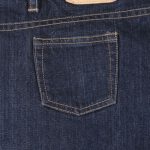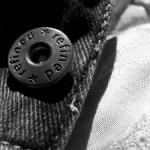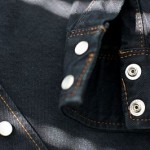Worn by millions of men, women and children on a daily basis, jeans have become the world’s most popular type of pants. Characterized by a denim construction, they offer the perfect balance of comfort, style and durability. Whether it’s the summer, fall, winter or spring, you can’t go wrong wearing a pair of high-quality jeans. When choosing a pair, though, you should pay attention to the number of pockets it has and where those pockets are located. While this may seem like a subtle design element, pocket configuration will affect the jeans’ appearance and functionality.
The First Pair of Jeans Had Four Pockets
According to Levi Strauss, the world’s first pair of denim jeans — originating in California during the Gold Rush — had four pockets. Granted, you may assume that these early-model jeans had two pockets in the front and two pockets in the back, but this isn’t necessarily true. Levi Strauss explains that the first pair of jeans actually had one pocket in the front and one pocket in the back, but each of these pockets had a second, smaller pocket inside it. This design has since been phased out in favor of the modern pocket configuration, which consists of two pockets in the front and two pockets in the back, all of which also have a smaller pocket inside it.
The Scoop on the Small Pocket: What You Should Know
Regardless of what type of jeans you own, they probably have small pockets inside the larger pockets. As previously mentioned, this was a staple element in the first pair of jeans. And even after all those years, manufacturers today continue to design jeans with small pockets inside the larger pockets. You can see for yourself by grabbing a pair of jeans out of your wardrobe and inspecting the front and back pockets. Although there are exceptions, most jeans have a single, small pocket inside each of its four pockets.
Based on the size of these small pockets, you might be wondering what, if any, purpose they serve. The small pockets are typically too small to store anything meaningful. You can’t place your smartphone, wallet or other items in them. They may fit some cash and loose change, but that’s about it. So, why do denim manufacturers continue to make jeans with these small pockets?
The small pockets were originally intended to store pocket watches. Back when the first pair of jeans was created — around the mid-to-late 1800s — jeans were sold to hardworking men and women, many of whom were aspiring gold prospectors hoping to strike it rich. And these men and women often carried a pocket watch so that they could keep track of the time. The problem, however, is that storing a pocket watch in a large pocket often resulted in the watch falling out. To prevent this from happening, manufacturers began designing jeans with a pocket watch.
Few people today carry or otherwise use pocket watches. Rather, most people keep track of the time using a wristwatch or smartphone. Nonetheless, denim manufacturers continue to make jeans with these same characteristically small pockets. It’s a simple feature that’s become synonymous with denim jeans. And because of this, it’s unlikely that denim manufacturers will stop using the small pocket watch pockets in the design of their jeans.
Non-Functional Pockets
Of course, there are also denim jeans that feature non-functional pockets. Non-functional pockets are designed to look like regular pockets from afar but with one major difference: They are sewn shut at the top. With non-functional pockets such as this, you won’t be able to store anything in your jeans. The good news is that most high-quality jeans have functional pockets in which you can store items. The only time when you’ll encounter non-functional pockets is when shopping for generic, low-quality jeans offered by no-name companies and brands. This is why it’s a good idea to spend the extra money on premium jeans offered by a reputable company or brand. You can expect to pay more for them, but it’s a smart investment that will offer you the highest level of utility and style.
Check the Depth
When choosing a pair of denim jeans, pay attention to the depth of the pockets. Conventional wisdom should tell you that deeper pockets offer increased utility, as you can use them to store additional, larger items. Different jeans are designed with different pocket depths. Some jeans have pockets just 2 inches deep, whereas others have pockets 4 or 5 inches deep. You don’t have to necessarily measure the depth of your pockets, but you should pay attention to their overall size. This is particularly important if you plan to store items like your car keys or smartphone inside them. If they are too small, you may be forced to store these items elsewhere, thereby increasing the risk of you accidentally losing them.
Unique Pocket Colors
While rare, some jeans are designed with unique colors that differ from the rest of the fabrics color. A pair of indigo jeans, for example, may feature light blue pockets. It’s a subtle nuance that adds a new level of visual appeal to jeans. If you want to create a unique look that’s not found in other jeans, consider buying a pair of jeans with unique pocket colors. It’s a fun way to differentiate your outfit from mainstream fashion. Just remember to pay attention to the depth of the pockets, especially if you intend to store items in your pockets.
Pocket configuration is just one thing to consider when shopping for a new pair of jeans. Perhaps even more important is the fit. You probably won’t wear a pair of jeans very often if they are too small or too big. Small jeans will restrict your movement, whereas large jeans look baggy and awkward. The bottom line is that you need to choose a pair of jeans in the right size for your body.












